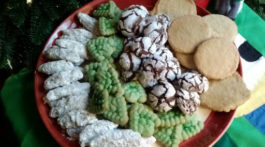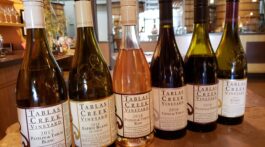My friend David likes to explore wine. I don’t think he’s made a formal study of the subject – just done lots of tasting, tried new wines and taken the advice and suggestions of friends and wine professionals. He knows what he enjoys but is always trying new wines, too. Over the course of a beach season, the empty bottles are lined up along the perimeter of his screened porch. David’s recent wine-drinking history can be contemplated while enjoying a glass of the current choice. The empty bottles testify to a broad and eclectic interest in wines. California and Italian reds appear often along with Chardonnay from around the world.
Lately he’s been sampling rosés. These lightly colored wines are made with red grapes, but the fermentation contact with the skins is very brief, limiting the amount of pigment and flavor imparted from the skins. The wines tend to be fresh, fruity, and crisp, with a wide range of pretty shades of pink – perfect for summer.
Rosé has been a favorite in the wine trade for years, offering fruit – driven flavor and refreshing crispness, not to mention the appealing color. It is widely consumed in France and produced for local consumption in most old-world wine-growing regions. But Rosé has been a tough sell to American consumers – we just don’t know what to make of this category, with its wide range of colors, diverse grape sources and varying flavor profiles. It’s an area ripe for exploration. I encourage you to jump in, get some suggestions from your favorite store and start tasting.
On a recent visit, David opened a bottle of Domaine De Fontsainte Gris de Gris from the Corbières region in France. A blend of Grenache and other traditional southern Rhône grapes yields a fragrant wine with delicious strawberry and tropical fruit flavors. Selected and Imported by the legendary Kermit Lynch, it is a smaller production wine, so you may have to ask for this one.
The next night he opened the last bottle of his favorite rosé from last summer. With the first sip, I wondered what he saw in the wine. Unlike the Fontsainte, it was dull and lackluster. David, too, found the wine markedly changed and not at all what he remembered. After some discussion, the bottle was put aside and another (very tasty) wine opened. Don’t be afraid to trust your taste buds and reject wines that disappoint. They do change over time, not always for the better.
Most wines do not benefit from aging, particularly fresh fruity wines like rosé. The vast majority of wine is made to be consumed soon after bottling. There are some reds and even a few whites that will benefit from cellaring under proper conditions of temperature and humidity, but these are the exceptions and usually carry steep prices.
Back to the rosés: they’re great for warm-weather drinking. The pretty colors, fresh-fruit flavors and crisp, bright freshness are ideal. Look for David’s current favorite rosé, Domaine De Fontsainte at Harry’s Wines in Fairfield. At Ancona’s Wines in Wilton, they’re recommending Bertani Bertarose from Italy – dry and crisp with flavors of cherry and strawberry, leading to a lingering finish; or Withers Rosé, a blend of Mourvedre and Grenache grapes from the El Dorado region in California’s Sierra Foothills. La Vieille Ferme, one of my go-to suppliers of readily available southern Rhône wines, makes a delicious and inexpensive Ventoux Rosé, which is widely distributed.
This summer I’ve enjoyed a couple of Italian reds that fit the summer wine profile. Nipozzano Riserva is a Chianti Rufina made in the shadow of a 1000 year old Fortress in Tuscany by the famous Frescobaldi family. The wine leads with an enticing and complex Sangiovese aroma of cherry, berry and currant and moves on to a classic Chianti flavor and long finish. It’s a complex and interesting wine – refreshing for summer but with enough flavor to pair well with backyard grilling. I had the 2009 vintage, but any available vintage will do. Look for it at Total Wine in Norwalk.
Montefalco Rosso from Umbria is 70% Sangiovese with Sagrantino (a grape indigenous to Umbria), Cabernet, and Merlot making up the balance. Bright cherry dominates the nose. The wine is well-balanced with a refreshing acidity that recommends it for summer drinking, and a long finish with enough tannin to match up with grilled meat. Look for it at Rowayton Wines and Spirits or Francos Wine Merchants in New Canaan.
As a final note, I want to sneak in a white wine – Bodegas Eidosela, a delightful white wine from Spain made from the Albarino grape, that we enjoyed with friends at the Bistro 7 in Ridgefield. Made by a grower co-operative in Rias Baixas, the wine’s fresh juicy flavors are balanced with a crisp but not overly tart finish. We all wanted more and the second bottle was quickly approved.
I love to broaden my experience with new wines from around the world. Some are more to my taste that others. Like David, I’m learning to put aside some that disappoint (use them for cooking) and focus on others that are more rewarding.











No Comment